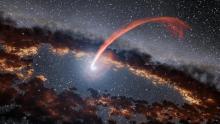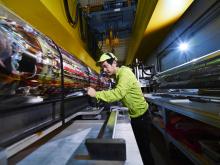Canadian researchers, including three physicists from UBC, have played a key role in an international project that has shot a beam of neutrinos from the eastern shore of Japan toward a detector 300 km away in the Japanese Alps.
The Tokai to Kamioka (T2K) long baseline neutrino oscillation experiment confirmed its first neutrino beam production yesterday. The 400-researcher project is studying the phenomenon of neutrino oscillations, the process by which one flavour of neutrino transforms into another.
The Canadian T2K group-which includes UBC physicists Christopher Hearty, Scott Oser and Hiro Tanaka-designed and built the 'tracker' for the project's near detector, working out of TRIUMF.
The near detector records the beam's initial properties as it is generated, allowing those results to be compared to the beam when it hits the final detector 300 kilometres away, after oscillation.
"The neutrino is perhaps the most elusive particle in the universe," said Nigel Lockyer, Director of TRIUMF, Canada's national laboratory for nuclear and particle physics based at UBC.
"This project moves us one step closer to understanding the role of the neutrino in the early universe. This is a great success for the international community and for Canada."
The T2K experiment, housed at the Japan Proton Accelerator Complex, involves 400 physicists from 12 countries. The T2K-Canada collaboration includes about 25 scientists, 25 technical staff and 10 students from UBC, the University of Alberta, University of Regina, University of Toronto, York University and TRIUMF.
Major Canadian contributions to the T2K beam line also include the off-axis beam design concept (a trick to get higher beam intensities at the correct energies), the proton beam transport scheme from the accelerator to the target, and the device which monitors critical properties of the incoming proton beam just before it strikes the target.
Neutrinos are elementary particles that belong to a category called leptons. Three types of neutrinos are known: electron neutrinos, muon neutrinos, and tau neutrinos. In 1998, the late Professor Yoji Totsuka, along with the Super-Kamiokande collaboration, discovered a phenomenon called neutrino oscillation.
More about TRIUMF: www.triumf.ca
Musqueam First Nation land acknowledegement
We honour xwməθkwəy̓ əm (Musqueam) on whose ancestral, unceded territory UBC Vancouver is situated. UBC Science is committed to building meaningful relationships with Indigenous peoples so we can advance Reconciliation and ensure traditional ways of knowing enrich our teaching and research.
Learn more: Musqueam First Nation
Faculty of Science
Office of the Dean, Earth Sciences Building2178–2207 Main Mall
Vancouver, BC Canada
V6T 1Z4


